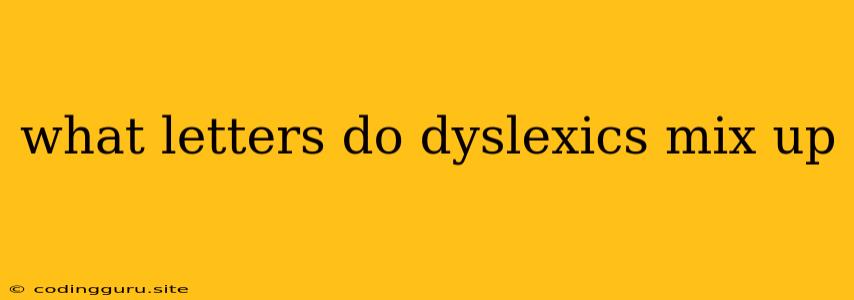What Letters Do Dyslexics Mix Up?
Dyslexia is a learning disorder that affects reading, writing, and spelling. People with dyslexia may have difficulty distinguishing between similar-looking letters, such as b and d, p and q, or m and w. This is because dyslexia can affect the way the brain processes visual information.
But why do they mix up specific letters? It's not just about letters looking similar, it's a combination of factors:
1. Visual Perception:
- Dyslexic individuals might struggle to visually differentiate between letters that share similar shapes, especially those with mirrored or reversed elements.
- Think of b and d or p and q. They are easily flipped in the mind's eye, leading to confusion.
2. Phonological Awareness:
- Difficulty with recognizing and manipulating sounds within words can lead to mispronunciation and spelling mistakes.
- This can cause confusion between letters with similar sounds, like c and k, or v and f.
3. Working Memory:
- Dyslexics may have difficulty holding onto and manipulating information in their working memory, making it harder to remember the correct order of letters in words.
- This contributes to errors in spelling, such as reversing letters in words or writing letters in the wrong order.
How can we help understand these letter confusions?
- Use Visual Aids: Use flashcards, colored pencils, or other visual tools to help learners differentiate between similar-looking letters.
- Emphasize Sound: Focus on the sounds of letters and how they sound together in words.
- Multi-Sensory Activities: Incorporate touch, movement, and sound into learning.
- Practice, Practice, Practice: Regular, targeted practice with letter identification and spelling can help reinforce correct associations.
Examples of Common Letter Confusions:
- b/d: These letters are mirror images of each other, making them difficult to distinguish.
- p/q: Similar to b/d, they are flipped versions of each other.
- m/w: These letters have similar shapes, especially when written quickly.
- n/u: The visual distinction can be subtle, especially in cursive handwriting.
- f/v: These letters have similar sounds, making them confusing in both spelling and pronunciation.
- c/k: These letters are often interchangeable, leading to confusion in spelling.
It's important to remember: Every individual with dyslexia is different. The specific letters that they struggle with will vary depending on the individual's unique challenges.
What can you do if you suspect dyslexia?
- Consult a qualified professional, such as a psychologist or educational specialist, for proper diagnosis and support.
- Be patient and supportive. Dyslexia is a lifelong learning difference, and individuals may need extra time and support to learn.
Conclusion:
While dyslexia can affect the ability to distinguish between certain letters, it's not a sign of low intelligence or lack of effort. Understanding the reasons behind these letter confusions helps us better support individuals with dyslexia and provide them with the necessary tools and resources to thrive.
